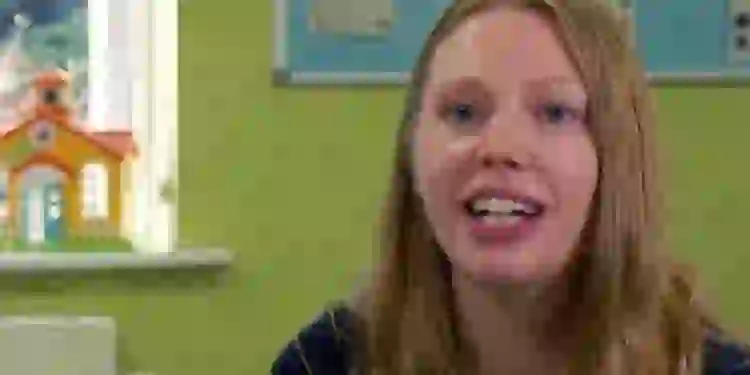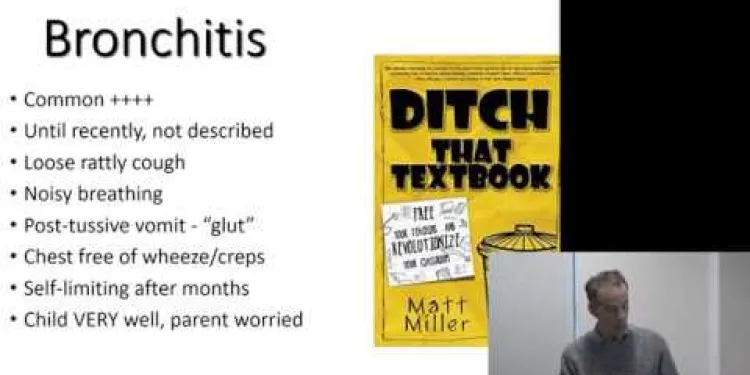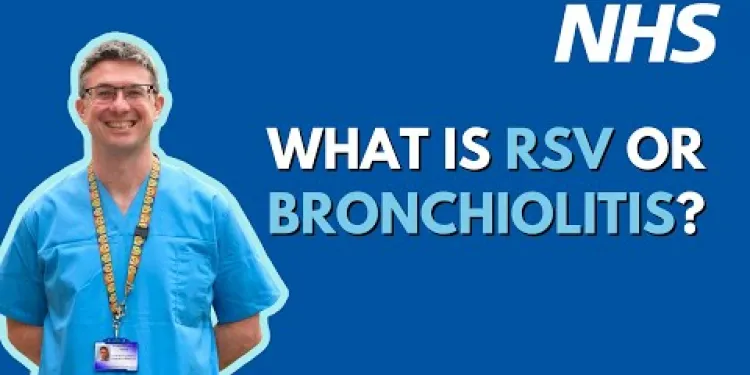Find Help
More Items From Ergsy search
-

Bronchiolitis Advice
Relevance: 100%
-

Bronchiolitis and chest infections in young children - Prof Steve Turner
Relevance: 83%
-

What is bronchiolitis in children? The symptoms, warning signs and when to seek medical help
Relevance: 79%
-

What is RSV (Respiratory Syncytial Virus) or bronchiolitis? UHL NHS Trust
Relevance: 75%
-

Understanding and Managing Respiratory Illnesses in Families
Relevance: 6%
Bronchiolitis Advice
What is Bronchiolitis?
Bronchiolitis is a common respiratory infection that affects the small airways, known as bronchioles, in the lungs. It primarily occurs in infants and young children, typically under the age of two. The condition is often caused by the respiratory syncytial virus (RSV) but can also be triggered by other viruses. Symptoms include coughing, wheezing, difficulty breathing, and a runny nose. While most cases are mild, some can become severe and require medical attention.
Symptoms to Watch For
Parents and caregivers should be vigilant for symptoms such as rapid breathing, wheezing, persistent cough, and feeding difficulties. Additional signs to watch for include lethargy, irritability, and signs of dehydration such as fewer wet nappies than usual. In severe cases, the child's lips or fingertips may turn blue, indicating a lack of oxygen. If any of these severe symptoms are present, immediate medical attention is necessary.
When to Seek Medical Help
While mild cases of bronchiolitis can often be managed at home, it is crucial to contact a healthcare professional if the child exhibits any signs of severe illness. This includes breathing difficulties, refusal to eat or drink, or exhibiting drowsiness and lethargy. In the United Kingdom, parents can call NHS 111 for advice or visit their GP for a more thorough evaluation. If the child’s condition worsens rapidly, it is essential to go to the nearest A&E department immediately.
Home Care Tips
For mild cases of bronchiolitis, ensure the child gets plenty of rest and fluids. Keeping the air moist with a humidifier can help ease breathing difficulties. Saline nasal drops can help clear nasal congestion, making it easier for the child to breathe, especially during feeding times. Over-the-counter pain relievers such as paracetamol can be used to reduce fever and discomfort, but always follow the dosage instructions and consult your GP if unsure.
Prevention Measures
Preventing bronchiolitis can be challenging, but there are steps you can take to reduce the risk. Good hygiene practices, such as regular hand washing and avoiding close contact with sick individuals, are critical. Keeping the baby's environment clean and smoke-free is also essential. During RSV season, usually autumn and winter, be extra cautious about exposing infants to crowded places. Breastfeeding can also boost the child's immune system, providing additional protection against infections.
Bronchiolitis Advice
What is Bronchiolitis?
Bronchiolitis is an illness that affects the small tubes in the lungs. These tubes are called bronchioles. It mostly affects babies and young children under two years old. Bronchiolitis is often caused by a germ called RSV, but other germs can cause it too. Signs of bronchiolitis include coughing, wheezing, trouble breathing, and a runny nose. Most children get better on their own, but some may need to see a doctor.
Symptoms to Watch For
Parents should look out for these signs: fast breathing, wheezing, a bad cough, and problems eating. Also, watch for tiredness, grumpiness, and not having many wet nappies. If the child’s lips or fingers look blue, they might not be getting enough oxygen. If you see these serious signs, take the child to a doctor right away.
When to Seek Medical Help
Mild bronchiolitis can often be cared for at home. But it's important to call a doctor if the child has a hard time breathing, won’t eat or drink, or seems very sleepy. In the UK, you can call NHS 111 for help or go to your GP. If the child's symptoms get worse quickly, go to the A&E right away.
Home Care Tips
For mild bronchiolitis, let the child rest and drink lots of fluids. Using a humidifier can help them breathe better. Saline nasal drops can clear a stuffy nose and help the child breathe during feeding. You can give them medicine like paracetamol to lower a fever, but always check the dosage and ask your GP if you’re unsure.
Prevention Measures
It can be hard to stop bronchiolitis, but you can try to lower the chances. Wash your hands often and keep the baby away from people who are sick. Keep their environment clean and free from smoke. Be extra careful during the autumn and winter months, which is RSV season. Breastfeeding can help make the child's immune system stronger.
Frequently Asked Questions
What is bronchiolitis?
Bronchiolitis is a common lung infection in young children and infants, causing inflammation and congestion in the small airways (bronchioles) of the lung.
What are the symptoms of bronchiolitis?
Symptoms of bronchiolitis include a runny nose, cough, slight fever, wheezing, and difficulty breathing. In severe cases, it can lead to a noticeable struggle to breathe.
What causes bronchiolitis?
Bronchiolitis is most commonly caused by the respiratory syncytial virus (RSV). It can also be caused by other viruses such as adenovirus, influenza, and parainfluenza.
How is bronchiolitis spread?
Bronchiolitis is spread through droplets from a cough or sneeze of an infected person. It can also be spread by touching contaminated surfaces and then touching the face or mouth.
Who is at risk of developing bronchiolitis?
Infants and young children, especially those under 2 years old, premature babies, and those with heart or lung conditions, are at higher risk of developing bronchiolitis.
How is bronchiolitis diagnosed?
Bronchiolitis is usually diagnosed based on medical history and a physical examination. In some cases, a chest X-ray or nasal swab test for viruses may be performed.
What treatments are available for bronchiolitis?
Most cases of bronchiolitis are mild and can be managed at home with supportive care like keeping the child hydrated and comfortable. In severe cases, hospitalization may be required for oxygen therapy and fluids.
Can bronchiolitis be prevented?
Good hygiene practices like frequent handwashing, keeping sick people away from infants, and cleaning surfaces can help prevent the spread of bronchiolitis. There is no vaccine for the common viruses causing bronchiolitis.
Is bronchiolitis contagious?
Yes, bronchiolitis is contagious. It spreads from person to person through droplets that are released when an infected person coughs or sneezes.
When should I seek medical help for bronchiolitis?
Seek medical help if your child is having difficulty breathing, shows signs of dehydration, has a high fever, or if their symptoms worsen or do not improve.
How long does bronchiolitis last?
Bronchiolitis usually lasts for about 7 to 10 days, with the worst symptoms occurring around the third to fifth day. Recovery may take longer in some cases.
Can adults get bronchiolitis?
While bronchiolitis primarily affects infants and young children, adults can develop similar symptoms from the same viruses, though it is typically less severe and referred to as bronchitis.
Is bronchiolitis the same as asthma?
No, bronchiolitis and asthma are different conditions. Bronchiolitis is an acute viral infection, while asthma is a chronic condition characterized by recurring episodes of airway narrowing and inflammation.
Can I use over-the-counter medications to treat bronchiolitis?
Over-the-counter medications like decongestants and cough suppressants are generally not recommended for young children with bronchiolitis. It's best to consult a healthcare professional for appropriate care.
What can I do to make my child more comfortable at home?
Ensure your child gets plenty of fluids, uses a cool-mist humidifier, keeps their head elevated, and gets adequate rest. Saline nasal drops can also help clear nasal congestion. Always consult your GP if symptoms are severe.
What is bronchiolitis?
Bronchiolitis is a sickness in your lungs. It can make it hard to breathe.
This happens mostly to babies and little kids.
If you need help understanding, ask someone you trust to explain it to you.
Use pictures or videos to help learn more.
Bronchiolitis happens when small tubes in the lungs get blocked. It is a common sickness in babies and young children. It can make it hard for them to breathe.
What are the signs of bronchiolitis?
Bronchiolitis affects the lungs and breathing. Here are some signs to watch for:
- Coughing a lot.
- Having trouble breathing or breathing fast.
- A wheezing sound when breathing.
- Feeling tired or fussy.
- Less appetite, not feeling hungry.
If you notice these signs, you can:
- Use a soft pillow to keep your head up when sleeping.
- Drink lots of water to stay hydrated.
- Talk to a doctor for advice and help.
Bronchiolitis is when your breathing tubes are a bit sick. You might have a runny nose, a cough, and a little fever. You could also hear a whistling sound when you breathe, and it can be hard to breathe.
If it gets worse, breathing can be even harder. You might see someone struggling to breathe.
For help, you can use a breathing machine called an inhaler. A grown-up or doctor can show you how it works.
What makes bronchiolitis happen?
Bronchiolitis is often caused by a virus called RSV. Other viruses like adenovirus, flu virus, and parainfluenza can also cause it.
How does bronchiolitis spread?
Bronchiolitis is a sickness that people can catch. It spreads when tiny drops from a cough or sneeze get in the air. These drops have tiny germs that make you sick.
You can get sick if:
- You touch things with these germs on them, like toys or door handles.
- You touch your face, nose, or mouth after touching something with germs.
Here are some tips to stay safe:
- Wash your hands often with soap and water.
- Use hand sanitizer if you can't wash your hands.
- Try not to touch your face with unwashed hands.
- Stay away from people who are coughing or sneezing.
Bronchiolitis is a sickness you can catch from tiny drops when someone coughs or sneezes. You can also get it by touching things that have those drops on them, then touching your face or mouth.
Who can get bronchiolitis?
Babies and young kids can get sick with bronchiolitis. Babies under 2 years old, babies born early, and kids with heart or lung problems have a higher chance of getting it.
How do doctors know if someone has bronchiolitis?
Doctors listen to your breathing.
They might take your temperature.
Sometimes, they will use a stethoscope to hear your lungs.
Doctors might want to see how much oxygen you have.
You can ask someone to go with you to the doctor if you are worried.
You can also write down questions before your visit.
Doctors usually tell if someone has bronchiolitis by asking about their health and checking them over. Sometimes, they might do a chest X-ray or test the nose for germs.
What can help if you have bronchiolitis?
Here are some things that can help if you have bronchiolitis:
- Rest: Make sure to take it easy and rest a lot.
- Drink Fluids: Drink lots of water or juice to stay hydrated.
- Breathing Help: Sometimes, you might need special help to breathe better.
- Doctor Visits: Go to the doctor if you feel very sick.
If you have bronchiolitis, a doctor can tell you what to do to get better. Sometimes using a humidifier or taking warm baths might help with breathing comfort.
Most of the time, bronchiolitis is not very bad. You can help your child at home. Give them lots to drink and keep them cozy.
If it gets very bad, the child might need to go to the hospital. There, they can get oxygen and drinks through a tube.
Can we stop bronchiolitis from happening?
Washing your hands often, keeping sick people away from babies, and cleaning things can help stop the spread of bronchiolitis. There is no shot to stop the common viruses that cause bronchiolitis.
Can you catch bronchiolitis from someone else?
Yes, bronchiolitis can spread from one person to another. It spreads when someone with bronchiolitis coughs or sneezes. Tiny drops come out of their mouth and can make other people sick.
When should I ask a doctor for help with bronchiolitis?
Bronchiolitis is an illness. It can make it hard to breathe.
You should call a doctor if:
- Your child has trouble breathing.
- Your child won't eat or drink.
- Your child seems very sleepy.
- Your child's skin turns blue or gray.
- Your child gets worse or does not get better.
Use calm words and videos to explain this to your child. You can ask the doctor questions.
If your child is having trouble breathing, not drinking enough, has a high fever, or if they do not get better, see a doctor.
How long does bronchiolitis last?
Bronchiolitis is an illness. It makes it hard to breathe. It happens mostly in little kids.
Bronchiolitis usually lasts about 1 to 2 weeks. Most kids start feeling better after a few days.
If you are worried about bronchiolitis, talk to a doctor. They can help and give advice.
Try using pictures or videos to learn more about bronchiolitis. It can make it easier to understand.
Bronchiolitis often lasts for 7 to 10 days. It gets the worst around days 3 to 5. Some people might take longer to get better.
Can grown-ups get bronchiolitis?
Yes, grown-ups can get bronchiolitis. It is when the small airways in the lungs get swollen.
If you think you or someone else might have it, see a doctor.
Reading tools can help make reading easier. There are also apps that read text out loud.
Bronchiolitis usually makes little kids feel sick. But grown-ups can get sick in a similar way. The same germs make them sick too. For adults, it's called bronchitis. Adults usually do not feel as sick as kids do.
Is bronchiolitis the same as asthma?
No, bronchiolitis and asthma are not the same.
Bronchiolitis is a lung illness caused by a virus. It mostly happens in babies. It makes it hard for them to breathe.
Asthma is a different lung condition. It can make people cough, wheeze, and feel tight in the chest. It happens to children and adults.
If you find reading difficult, try using audiobooks or text-to-speech tools. They can read the information out loud for you.
No, bronchiolitis and asthma are not the same thing. Bronchiolitis is an illness caused by a virus. It happens quickly and lasts a short time. Asthma is a long-term condition. It can make it hard to breathe because the airways get narrow and swollen again and again.
Can I use store-bought medicine for bronchiolitis?
Bronchiolitis is a sickness that affects the lungs, mostly in little kids. If your child has bronchiolitis, talk to a doctor first. A doctor can tell you the best way to help your child feel better.
There are special things the doctor might recommend. This can include things like lots of rest, drinking water, and keeping away from smoke.
Over-the-counter (store-bought) medicines, like cold and cough syrups, usually don’t help bronchiolitis. Sometimes, they can make things worse.
Always ask a doctor or nurse before giving store-bought medicine to your child. They know how to keep your child safe.
If your child is having trouble breathing, or seems very sick, go to the doctor or hospital right away.
Medicines you can buy at the store, like ones for stuffy noses and coughs, are not good for young kids with bronchiolitis. It’s important to talk to a doctor for the right help.
How can I help my child feel happy at home?
Here are some ideas to help your child feel good at home:
- Make a special place for your child to play and relax.
- Ask your child what they like or need.
- Read together or tell fun stories.
- Play games and do fun activities as a family.
- Give your child a hug or tell them you love them.
Make sure your child drinks lots of water. Use a machine that makes cool mist to help them breathe better. Raise their head up a bit when they sleep or rest. This can help them feel better.
You can use special nose drops to help clear a stuffy nose.
If your child feels very sick, talk to your doctor. They can help you know what to do.
Useful Links
- Ergsy carfully checks the information in the videos we provide here.
- Videos shown by Youtube after a video has completed, have NOT been reviewed by ERGSY.
- To view, click the arrow in centre of video.
- Most of the videos you find here will have subtitles and/or closed captions available.
- You may need to turn these on, and choose your preferred language.
- Go to the video you'd like to watch.
- If closed captions (CC) are available, settings will be visible on the bottom right of the video player.
- To turn on Captions, click settings .
- To turn off Captions, click settings again.
More Items From Ergsy search
-

Bronchiolitis Advice
Relevance: 100%
-

Bronchiolitis and chest infections in young children - Prof Steve Turner
Relevance: 83%
-

What is bronchiolitis in children? The symptoms, warning signs and when to seek medical help
Relevance: 79%
-

What is RSV (Respiratory Syncytial Virus) or bronchiolitis? UHL NHS Trust
Relevance: 75%
-

Understanding and Managing Respiratory Illnesses in Families
Relevance: 6%

